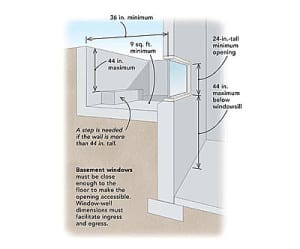Inspecting basement egress rescue openings – It should be no surprise that there are specific requirements for basement egress windows and rescue openings. As a

Basement egress & rescue openings
home inspector, it is important to familiarize yourself with these requirements. Local regulations and codes vary across the country, so be sure to familiarize yourself with the requirements in your area to make yourself a more knowledgeable home inspector.
Not all basement rooms need a legal egress window. Where basements contain one or more sleeping rooms, emergency egress and rescue openings are required in each sleeping room. Remember, as home inspectors, safety is our number one priority for occupants, so corners should not be cut when inspecting this aspect of a basement.
Below are some important numbers and rules to keep in mind when inspecting basement bedrooms that have emergency escape and rescue opening(s).
Here is what the 2012 IRC Code states:
- The maximum sill height, measured from the finished floor to the bottom of the clear opening is 44 inches.
- The minimum opening area is 5.7 square feet (Exception is grade floor openings, which must have a minimum net clear opening of 5 square feet).
- The minimum opening height is 24 inches.
- The minimum opening width is 20 inches.
- The minimum horizontal area of a window well is nine square feet, with a minimum horizontal projection and width of 36 inches. The area of the window well must allow the emergency escape and rescue opening to be fully opened.
- Window wells shall be equipped with a permanently installed ladder or steps if the vertical depth of the window well is greater than 44 inches. The ladder or steps must be usable with the window fully open.
- The ladder may project six inches into the required window well space.
- Emergency escape and rescue openings need to be operational from the inside without the use of keys, tools or special knowledge.
- Emergency escape windows under decks and porches are allowed as long as the deck allows the emergency escape window to be fully opened and provides a path not less than 36 inches in height to a yard or court.
Once again, local regulations and codes may vary from these IRC codes, so be sure to familiarize yourself with what is required in your area in order to properly inspect basement egresses and rescue openings.
Signature Home Inspection is a Certified Home Inspection service located in California serving Orange County, San Diego County, Los Angeles County, Riverside County, Santa Clara County, San Mateo County, San Francisco County, Contra Costa County, and San Bernardino County California.
www.signaturemore.com 888-860-2688


